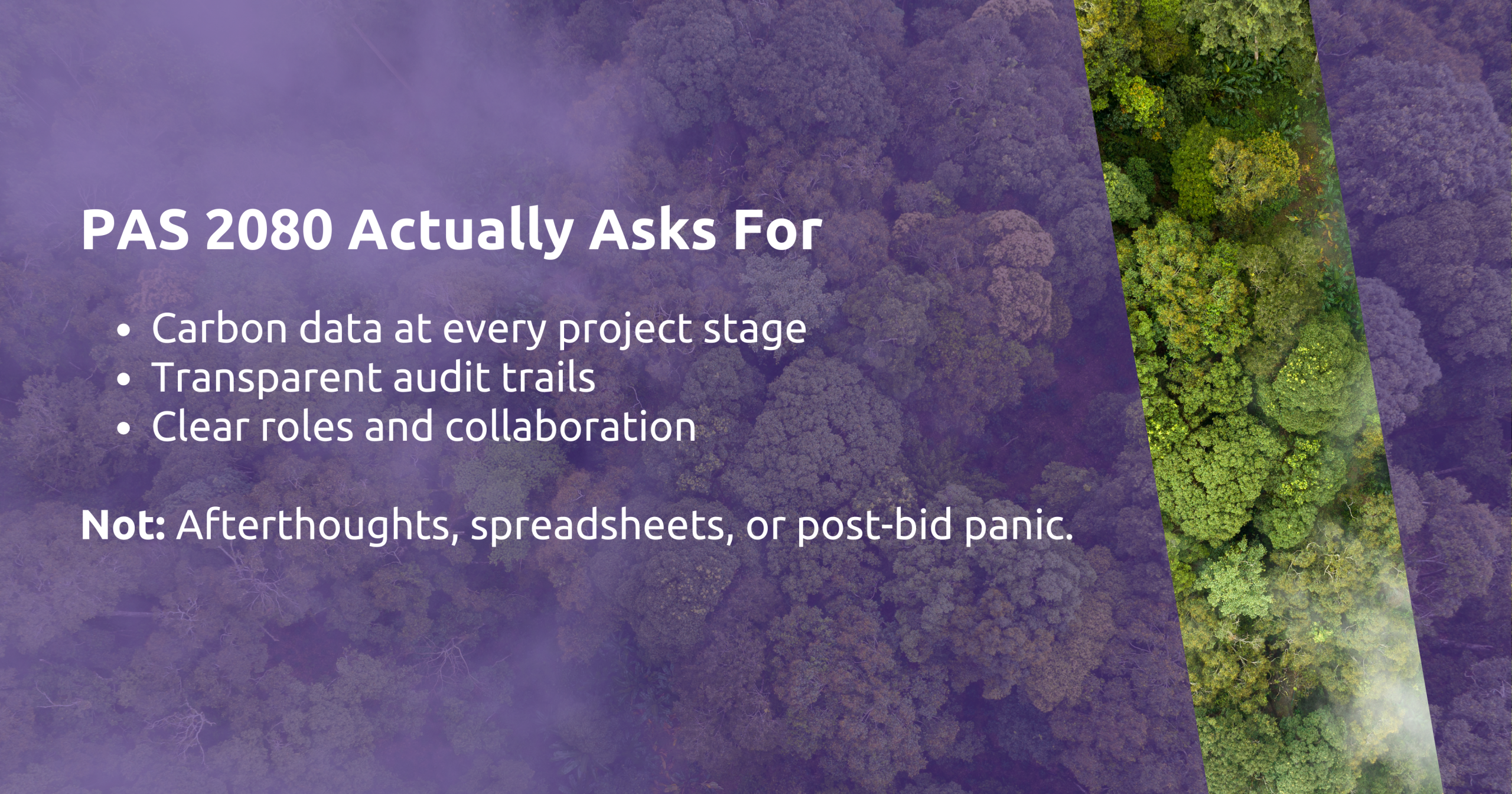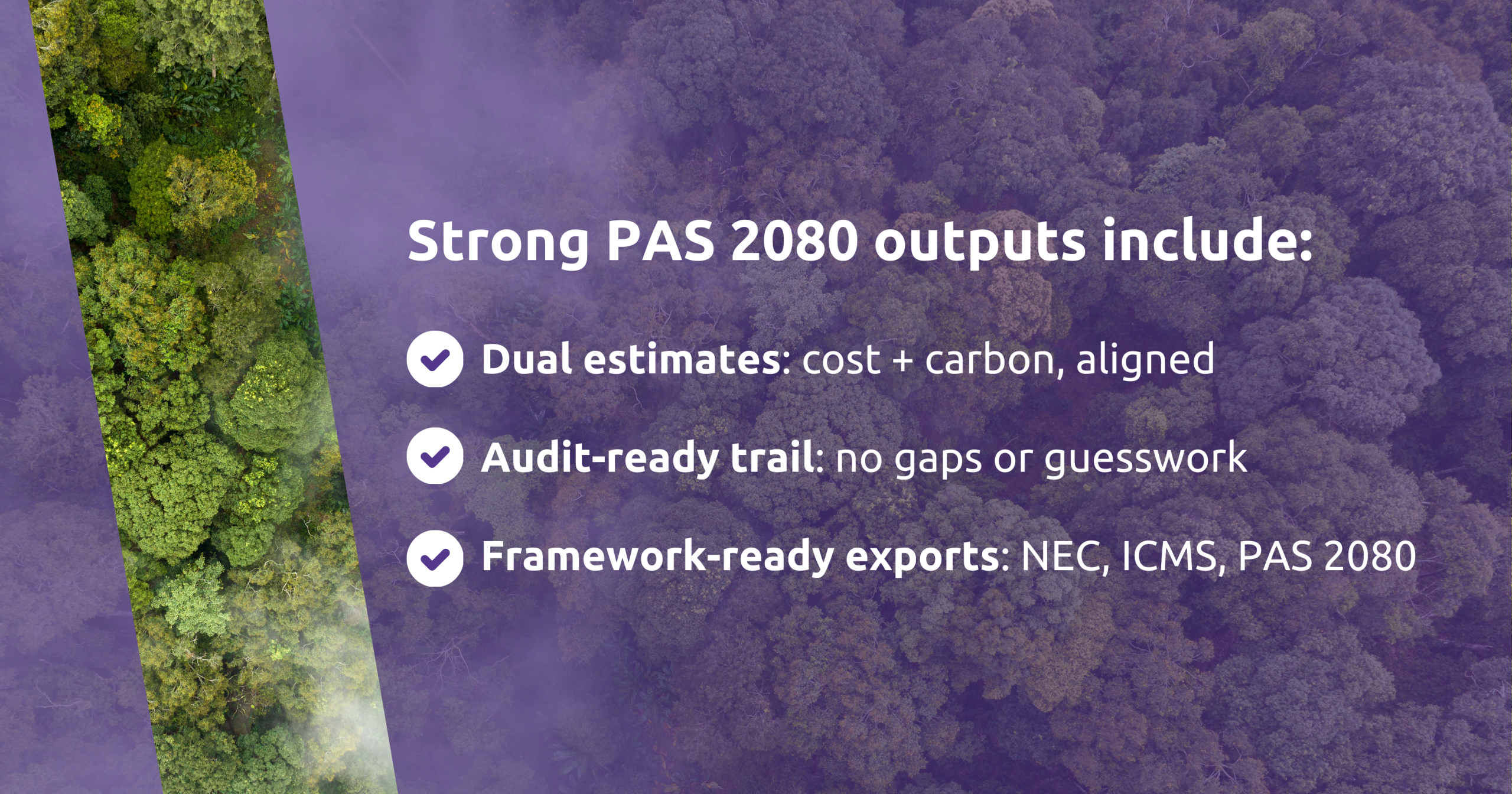If you’re bidding into public frameworks or managing capital projects under Net Zero mandates, PAS 2080 isn’t optional, it’s expected. But for many preconstruction teams, aligning with this carbon management standard still feels like a slow, manual burden. More spreadsheets. More reporting. More ways to lose time you don’t have.
At Sterling DCS, we fundamentally believe that it doesn’t need to be that way.
PAS 2080 alignment can unlock clarity, not just compliance — if you embed it early and get the workflows right. In this guide, we’ll show how preconstruction teams can meet the standard without sacrificing speed, and why carbon-integrated estimating is becoming a competitive advantage, not just a checkbox.
Let’s break down what PAS 2080 really asks of you, and how to deliver on it without slowing down.
What is PAS 2080, and Why Should Preconstruction Teams Care?
PAS 2080 is the UK’s specification for managing carbon in infrastructure. It sets out how organisations should measure, reduce, and report embodied and operational carbon across the asset lifecycle, from design and materials to delivery and maintenance.

At its core, PAS 2080 isn’t just a technical requirement. It’s a framework for proving that your project is taking carbon seriously, with data, not just declarations.
So why does this matter in preconstruction?
Because this is where carbon performance gets locked in. Decisions made during early-stage planning, design options, material choices, procurement models, account for the majority of an asset’s lifetime emissions. And increasingly, this is where clients, funders, and frameworks are demanding carbon accountability.
For contractors and consultants bidding into regulated frameworks or public sector work, PAS 2080 alignment is no longer a “nice to have.” It’s a commercial filter. Your ability to quantify carbon at tender stage can directly influence bid scores, audit outcomes, and approval timelines.
That’s why aligning early — and doing it efficiently — is no longer just about compliance. It’s about competitiveness.
The Compliance Challenge
PAS 2080 might be clear in theory, but in practice, alignment is often anything but. Preconstruction teams are already stretched across cost planning, procurement strategy, and bid delivery. Adding carbon reporting to the mix, especially without dedicated tools, can feel like one responsibility too many.
Most teams face three common blockers:
1. Fragmented workflows
Cost, carbon, and commercial teams often work in silos. Estimates are built in one place, carbon data tracked in another. Reconciliation is manual, time-consuming, and prone to error.
2. Lack of practical tools
Even when the will is there, the tools often aren’t. Traditional estimating platforms don’t support carbon. Sustainability software doesn’t speak cost. That leaves teams bridging the gap with spreadsheets and workarounds.
3. Unclear ownership
In many bids, it’s not obvious who owns PAS 2080 compliance. Estimators focus on price, sustainability leads focus on targets, and no one has the full picture. The result? Delays, missed metrics, or inconsistent outputs that don’t stand up to audit.
The risk isn’t just operational. Bids can be marked down. Frameworks can reject submissions. Public sector clients, under increasing regulatory scrutiny, need partners who can show compliance with confidence, and provide the data to prove it.
So, the challenge is clear. The question is how to solve it without slowing down.
Busting the Myth that “PAS 2080 Slows You Down”
There’s a common belief in preconstruction: if you want to comply with PAS 2080, you need to slow down. More reports. More reviews. More back-and-forth between cost and carbon teams. It’s a belief rooted in experience, because with legacy tools and disconnected workflows, that’s often exactly what happens.
But it doesn’t have to.
The real problem isn’t PAS 2080 itself. It’s how most teams try to meet it, by layering sustainability on top of existing estimating processes rather than integrating it from the start. That’s where the delays creep in. Reworking outputs. Manually reconciling carbon figures. Chasing data across systems that don’t talk to each other.
At Sterling DCS, our approach is different.
We built our platform to estimate cost and carbon together, in real time, using the same data structures and classifications.
No exporting. No reformatting. No rework. Compliance becomes a natural output of your existing workflows, not a separate task to be managed later.
That means faster bids, cleaner outputs, and less pressure on already overloaded teams.
Three Fast Paths to PAS 2080 Alignment
You don’t need to overhaul your workflows to meet PAS 2080. You just need to align early, structure your data right, and let your tools do the heavy lifting. Here are three fast, practical ways to get there, without slowing your team down.
1. Classify Right, From the Start
PAS 2080 requires transparency. That means your estimates need to be structured in a way that supports carbon analysis and audit. Using a platform that supports ICMS classification out of the box ensures that your cost and carbon data is aligned, consistent, and exportable by framework.
Sterling makes this easy. Every line item in your estimate can be tagged and tracked for both cost and embodied carbon, ready for audit without extra formatting.
2. Connect Teams, Not Just Data
Most delays happen when estimating and sustainability teams work in isolation. PAS 2080 calls for collaboration, not just compliance.
Sterling is built for both. Shared templates, unified reports, and live syncing mean everyone works from the same source of truth. Estimators see carbon. Sustainability leads see cost. And outputs align without last-minute panic.
3. Export With Confidence
Frameworks want to see evidence, not just effort. That means your outputs need to speak their language: PAS 2080 alignment, NEC-compatible structures, and reporting formats they can trust.
With Sterling, your estimates are export-ready by default. Whether it’s for internal governance, external assurance, or bid submission, you get outputs designed to pass scrutiny, not just meet minimums.
What ‘Good’ Looks Like: PAS 2080 Outputs That Win Work
Meeting PAS 2080 is one thing. Proving it, clearly, consistently, and convincingly, is what wins work.
Good outputs don’t just tick compliance boxes. They show clients and evaluators that your team understands the assignment. That you’ve built carbon into your commercial logic. That you’re not treating sustainability as a side-note, but as part of your value proposition.

-
- Dual estimates: Integrated cost and carbon data, broken down by classification and stage. No manual matching. No spreadsheets to reconcile.
-
- Audit trails: Transparent records of how figures were calculated, where assumptions were made, and what data sources were used.
-
- Framework-ready formats: Outputs structured to align with NEC, ICMS, and public sector requirements, ready to be submitted with no extra formatting.
Sterling enables all of this by default. From day one, your estimates are structured to align with PAS 2080 and ready to stand up to scrutiny. That means fewer revisions, less rework, and more confidence in every submission.
And when clients see that level of clarity, it doesn’t just help you meet the standard. It helps you stand out.
Turning PAS 2080 Compliance into a Competitive Edge
For many teams, PAS 2080 feels like a risk, a hurdle to clear, a source of extra effort. But when done right, it becomes something far more valuable: a differentiator.
Bids that meet the minimum get through. Bids that demonstrate integrated cost and carbon thinking win.
Framework evaluators are under pressure to choose partners who can prove they’re ready to deliver on Net Zero goals. That means they’re looking beyond narrative claims. They want outputs that show exactly how carbon has been considered, quantified, and managed, right from preconstruction.
With Sterling, compliance isn’t a bolt-on. It’s embedded. That turns what used to be a reporting burden into a strategic advantage:
-
- You back up your bids with real carbon metrics.
-
- You avoid delays caused by rework or data gaps.
-
- You build trust by submitting outputs that match what frameworks now expect.
In a tight market, that edge can be the difference between shortlist and win. Between rework and readiness. Between being seen as a risk, or the safe, credible choice.
Next Steps: How to Move Fast Without Breaking Flow
If PAS 2080 alignment has felt like a blocker in the past, it’s time to reframe it. With the right structure and the right tools, compliance becomes part of how you work, not an extra layer on top.
Sterling is built to help you get there without disruption:
-
- Fast start, no friction: Onboard in days, not weeks. No IT bottlenecks, no complex setups.
-
- Excel-compatible, not Excel-bound: Work how you already do, with smarter outputs and fewer risks.
Support that understands your world: From NEC frameworks to carbon benchmarks, we’ve seen what compliance-ready looks like, and we’re here to help you deliver it.
Want to see how it works in practice? Book a free Sterling demo and discover how we help you go beyond compliance.

